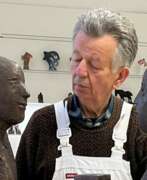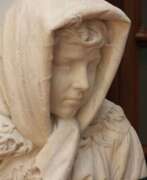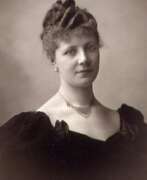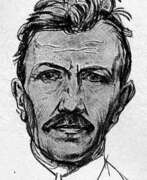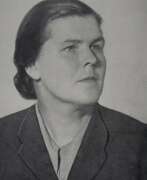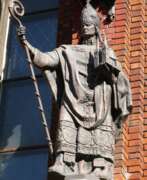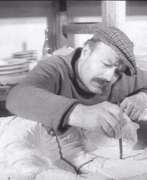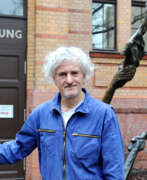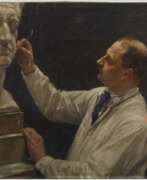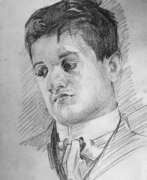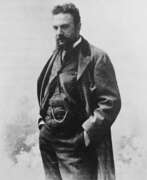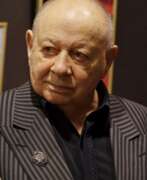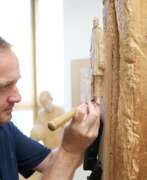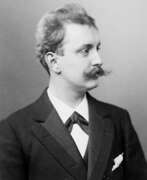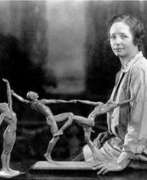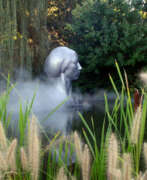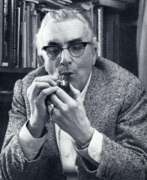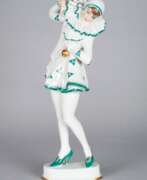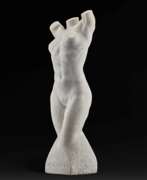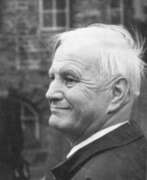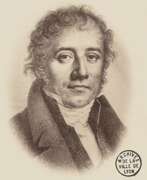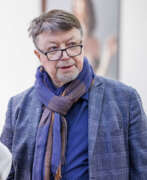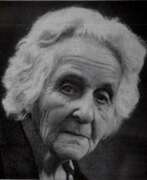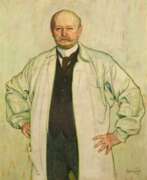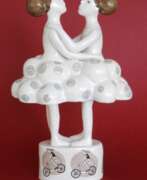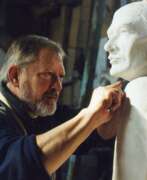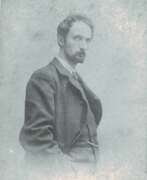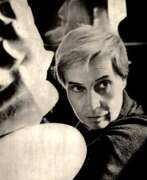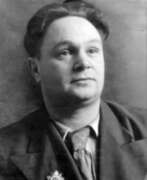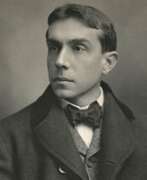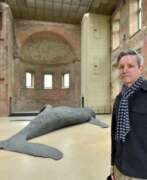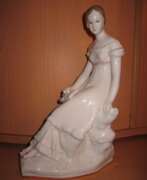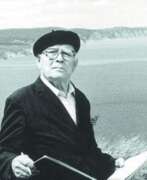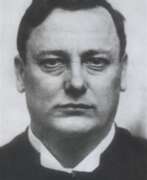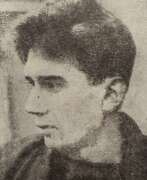Educators Portrait sculpture
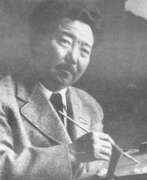

Gapar Aitievich Aitiev (Russian: Гапар Айтиевич Айтиев), a pioneering figure in Soviet Kyrgyz art, was born in 1912 and became a cornerstone of Kyrgyz cultural heritage through his impactful contributions as an artist and educator. Aitiev's journey in art began at the Moscow Art School in Memory of 1905, where he studied under N. P. Krymov between 1935 and 1938, laying the groundwork for his illustrious career. His profound connection to his Kyrgyz roots was reflected in his artwork, characterized by epic, poetic landscapes of Kyrgyzstan, such as "Midday on Issyk Kul" (1954), and detailed portraits like the "Gallery of portraits of contemporaries" (1979). Aitiev's contributions to the art world earned him the prestigious titles of People’s Artist of the USSR and Hero of Socialist Labor, marking his influence on Soviet and Kyrgyz art history.
The Gapar Aitiev Kyrgyz National Museum of Fine Arts, named in his honor, stands as a testament to his legacy, showcasing not only his work but also a broad spectrum of Kyrgyz and Russian art, spanning from traditional Kyrgyz artifacts to contemporary works post-independence. This museum, alongside the Gapar Aitiev Memorial Studio Museum in Bishkek, provides insight into Aitiev's life, offering a personal glance at his workspaces and the art that filled his surroundings. These institutions preserve and celebrate Aitiev's dedication to portraying the tranquil beauty of Kyrgyz landscapes and the spirit of its people, making his work an integral part of Kyrgyz national identity.
For those interested in the rich tapestry of Central Asian art, visiting these museums in Bishkek is a journey through the heart of Kyrgyz culture and history, brought alive by Aitiev's artistic vision. His work not only captures the essence of Kyrgyzstan's landscapes and people but also serves as a bridge between the traditional and the modern, embodying the nation's cultural evolution.
To stay updated on exhibitions and events celebrating Gapar Aitievich Aitiev's legacy and to explore more about his contributions to art and culture, consider signing up for updates. This subscription will keep you informed about new product sales and auction events dedicated to Aitiev's work, ensuring that enthusiasts and collectors alike remain connected to the vibrant world of Kyrgyz art.
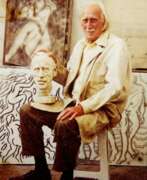

Harold Ambellan is an American painter and sculptor.
He studied sculpture and fine art in Buffalo before moving to New York City. The human figure is central to Harold Ambellan's work. He created monumental figures and drew extensively, leaving thousands of drawings. Ambellan was one of the participants in Roosevelt's Federal Art Project, which hired hundreds of artists during the Great Depression who collectively created more than 100,000 paintings and over 18,000 sculptures.
Ambellan remained committed to figuration in both his sculpture and painting. He was elected president of the Sculptors Guild of America in 1941, and that same year his work was exhibited in group shows at the Metropolitan Museum of Art in New York and the Academy of Fine Arts in Philadelphia.
In 1944, Ambellan participated in the liberation of Normandy as part of the U.S. Navy, then taught three-dimensional art at the Workshop School in New York City. In 1954, for political reasons, Ambellan moved to France and remained there for the rest of his life, working and exhibiting throughout Europe.
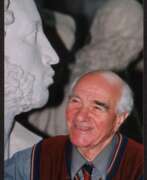

Mikhail Konstantinovich Anikushin (Russian: Михаил Константинович Аникушин) was a Soviet and Russian sculptor, celebrated for his monumental works that have left a lasting legacy in the art world. Born on September 19, 1917, in Moscow, Anikushin's sculptures are a testament to his profound skill and dedication to depicting historical and cultural figures with a dynamic expressiveness that brought them to life. His most notable works include monuments dedicated to Alexander Pushkin, found at the Pushkinskaya Station of the Saint Petersburg Metro and Arts Square in Saint Petersburg, as well as a monument to Vladimir Lenin at Moskovskaya Square in Saint Petersburg.
Anikushin's career was distinguished not only by his artistic achievements but also by the honors he received, reflecting the impact of his work on Russian culture. He was awarded the title of "Honored Artist of the RSFSR" in 1957, "People's Artist of the USSR" in 1963, and became a full member (academician) of the Russian Academy of Arts in 1962. His dedication to capturing the spirit and essence of his subjects, particularly Alexander Pushkin and Vladimir Lenin, showcases his innovative approach to sculpture, moving beyond traditional standards to depict his subjects in active, dynamic poses.
The Presidential Library collection dedicated to Anikushin commemorates the 100th anniversary of his birth, highlighting his significant contributions to Russian sculpture in the 20th century. Anikushin's works are integral to the aesthetic and cultural landscape of Leningrad (now Saint Petersburg), contributing to the city's historical and artistic identity. The collection also emphasizes his role in the community, including his public service and the enduring influence of his artistic vision on generations to come.
Collectors and experts in art and antiques recognize Mikhail Konstantinovich Anikushin not only for his technical prowess but also for his ability to imbue his sculptures with a sense of movement and emotional depth that resonates with viewers. His works remain landmarks, celebrated both in Russia and internationally, for their contribution to the cultural heritage.
For those interested in exploring the works and legacy of Mikhail Konstantinovich Anikushin further, signing up for updates can provide invaluable insights into new discoveries, exhibitions, and auction events related to this influential sculptor. This subscription is an opportunity to stay informed about the sales and exhibitions that continue to celebrate Anikushin's remarkable contribution to the world of sculpture.
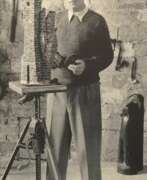

Otto Baum is a German sculptor and university lecturer and member of the German Artists' Association.
He studied painting at the Stuttgart Academy of Art and sculpture at the same time. From the mid-1930s, the National Socialists who came to power in Germany forbade Baum to exhibit or even work, and he was persecuted as a representative of "degenerate art".
After the war, Otto Baum was appointed to teach at the Stuttgart Academy of Art and was regarded as the most progressive and extremely critical teacher among the young students at the academy.
Otto Baum is considered one of the most important representatives of classical modernism, who had a significant influence on European sculpture in the second half of the 20th century both through his work and as a teacher.


Ekaterina Feodorovna Belashova (Russian: Екатерина Фёдоровна Белашова) was a Russian sculptor renowned for her profound contributions to Soviet sculpture. Born in St. Petersburg in 1906, she later moved to Moscow to further her education and career. Belashova began her artistic journey at VKHUTEIN, studying under notable figures such as R. Bach and A. Matveev. Her career saw her become a revered professor at the Moscow Institute of Applied and Decorative Arts and the Moscow School of Industrial Arts.
Her works, celebrated for their delicate silhouettes and meticulous attention to proportions, delve into the emotional and physical resilience of individuals, particularly during the turbulent times of war. Belashova's sculptures often embody the spirit of her era, exploring themes of loss, hope, and the enduring strength of the human spirit. Notable works include "The Fighter," "Unvanquished," and a series dedicated to the memory of the victims of fascism, showcasing her ability to capture the essence of her subjects with both sensitivity and strength.
Belashova's sculpture, "Girl with a garland in her hair," exemplifies her skill in capturing youth and vitality, showcasing a young girl in a moment of introspection and grace. This piece highlights Belashova's mastery over bronze, a material she often utilized despite its scarcity in the post-war period.
Throughout her life, Belashova remained deeply connected to the art world, not only through her creations but also as an educator and influencer in the Soviet art scene. Her contributions were recognized with numerous awards, including the prestigious State Prize of the USSR. Belashova's legacy is one of artistic excellence and profound humanity, leaving an indelible mark on the world of sculpture.
For collectors and experts in art and antiques, Ekaterina Feodorovna Belashova's work offers a deep dive into the rich tapestry of Soviet-era sculpture, characterized by its emotional depth and aesthetic finesse. Sign up for updates on new product sales and auction events related to Ekaterina Feodorovna Belashova, and explore the enduring beauty of her contributions to the world of art.
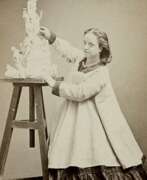

Hélène Bertaux, born Joséphine Charlotte Hélène Pilate, was a French painter and sculptor who achieved equal rights with men.
Hélène Pilate trained as a teenager in the workshop of her stepfather Pierre Hébert, where she modeled designs for watches, then regularly received commissions for small decorative bronze pieces. Aspiring to become a professional sculptor, she completed her studies with Augustin Dumont (1801-1884) in the academic tradition. The support of the imperial couple enabled her to become one of the few women to make a name for herself in the field of monumental sculpture: in 1864 she created the Fontaine Herbet for the Place Longueville in Amiens and during her career she received several prestigious commissions for religious and public buildings.
After achieving success and official recognition, Hélène Bertaux advocated for equality between men and women in the arts. In 1873, Hélène Bertaux opened her first sculpture studio, and in 1879, she opened another one with a sculpture school for women. Her students, including Clémence-Jeanne Eymard de Lanchâtre (1854-1894) and Jenny Weil (1851-1933), later won prizes at the Salon. The creation in 1881 of the Union of Women Painters and Sculptors, of which she was president from 1881 to 1894, marked a new step in her fight for gender equality in academic education. Hélène Bertaux became the first female member of the Salon jury and received a gold medal at the 1889 World's Fair.


Vladimir Nicholaevich Domogatsky (Russian: Владимир Николаевич Домогацкий) was a Russian sculptor, teacher, and Honored Art Worker of the RSFSR, known for his contribution to the development of Soviet sculpture. Born in Odessa in 1876 and spending his early years in Switzerland and Ukraine, Domogatsky's life and career were predominantly centered in Moscow. He studied law at Moscow University and then took up sculpture under the tutelage of S.M. Volnukhin and S.V. Ivanov. Domogatsky's work was greatly influenced by the works of P. P. Trubetskiy, Auguste Rodin, the animalist painter R. Bugatti and others. Travels to Paris and Italy contributed to the improvement of his skills, especially in working with marble.
Domogatsky's work was diverse: genre, animalistic and portrait sculpture. Notable works include Boy in a Coat (1904), Portrait of an Old Actor (1913), and Portrait of Lev Shestov (1917), demonstrating his skill in merging Russian sculptural traditions with Western European influences. Teaching at the Moscow Institute of Fine Arts, organizing and participating in exhibitions all attest to his significant influence on the Soviet art scene. His works are held in prestigious museums, including the State Tretyakov Gallery, reflecting his enduring legacy in Russian art.
For collectors and experts, Domogatsky's sculptures represent a unique combination of historical and cultural narrative, embodied in the subtlety of his craftsmanship. His contributions to monumental propaganda and theoretical developments in sculpture further cement his status as a key figure in 20th century Soviet art.
To keep abreast of exhibitions and auctions featuring works by Vladimir Nikolayevich Domogatsky, we encourage you to subscribe to our updates. By subscribing, you will be the first to know about new sales and auction events related to this esteemed artist and enrich your collection with items of significant historical and artistic value.
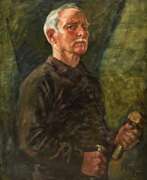

John Stuart Dowie was an Australian painter, sculptor and teacher.
His work includes over 50 public sculpture commissions, including the "Three Rivers" fountain in Victoria Square, "Alice" in Rymill Park, the "Victor Richardson Gates" at Adelaide Oval and the "Sir Ross & Sir Keith Smith Memorial" at Adelaide Airport. He was nominated for Senior Australian of the Year in 2005, and was made a Member of the Order of Australia in 1981 in recognition of service to the arts as a sculptor and painter.
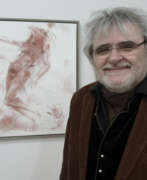

Thomas Duttenhoefer was a German sculptor, draughtsman, graphic artist, and illustrator, and professor at the University of Mannheim.
In addition to his human figures, Thomas Duttenhoefer's figurative work includes many depictions of animals in a deliberately crude manner.
He is a member of the New Darmstadt Secession, the Palatinate Secession and the Argo Group, Speyer.
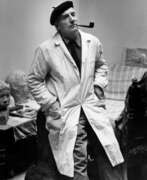

Stanisław Horno-Poplawski was a Polish sculptor, artist and teacher.
In the late 1910s, young Stanisław became interested in painting and art in Moscow, where his family moved from Georgia, then continued his studies at the Warsaw School of Fine Arts. Stanisław Gorno-Poplawski made the subject of his sculpture a rough field stone, giving it the features of famous and unknown Poles' faces, creating compositions filled with life. His works can be seen in many museums in Poland and the world.
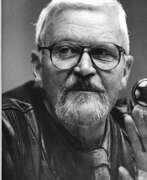

Jo Jastram, born Joachim Jastram, is a German sculptor.
Jastram studied at the Dresden University of Fine Arts and then at the University of Fine and Applied Arts in Berlin-Weißensee, earning a degree in sculpture. Later he taught himself at several universities and was a member of various state and public cultural associations. The sculptor was repeatedly awarded the Art Prize of the GDR.
Jo Jastram created an extensive collection of portraits during his long life, as well as many diverse compositions and sculptures in public spaces. Some of his most famous works are the "Fountain of the Joy of Life" on University Square in Rostock, created in 1978 in collaboration with Reinhard Dietrich, as well as "The Great African Journey" (1983), installed in Rostock's city harbor in 2008.
Jo Jastram's three sons Matthias, Michael, Jan Jastram and daughter Susanne Rast became painters and sculptors, and the sculptor Thomas Jastram is his nephew.
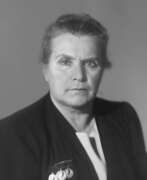

Vera Ignatyevna Mukhina (Russian: Ве́ра Игна́тьевна Му́хина) was a renowned Soviet sculptor and artist, celebrated for her significant contributions to Soviet art and sculpture. Born into a wealthy merchant family in Riga, Mukhina's journey into the world of art took her through the studios of notable artists in Russia and Europe, including the Académie de la Grande Chaumière in Paris under Antoine Bourdelle. Her work is deeply imbued with a sense of national pride and a commitment to the socialist cause, reflecting the tumultuous times she lived through, including both World Wars and the shifting political landscape of the Soviet Union.
Mukhina's most celebrated piece, "Worker and Kolkhoz Woman," a towering sculpture made of stainless steel, was originally created for the 1937 World's Fair in Paris. This sculpture, standing as a symbol of Soviet might and unity, showcases Mukhina's mastery in welding and her innovative approach to monumental art. The piece was acclaimed internationally and continues to be a significant symbol of Soviet and Russian culture.
Throughout her career, Mukhina experimented with a variety of materials and techniques, including glass, earning her numerous awards, such as the Stalin Prize, which she received five times, and the title of People's Artist of the USSR. Her commitment to art went beyond her own creations; she was a passionate educator and theorist, advocating for the enrichment of Soviet artistic vocabulary and experimenting with new materials and forms.
Mukhina's legacy extends beyond her sculptures to her contributions to the art world through her theoretical writings, her influence on public and architectural sculpture, and her experimentation with art glass, transforming ordinary objects into decorative art pieces. Her works are preserved in museums and public spaces, continuing to inspire and evoke admiration.
For collectors and experts in art and antiques, Mukhina's works represent a poignant narrative of 20th-century Soviet art, characterized by its boldness, innovation, and ideological commitment. Her life's work offers a window into the complexities of Soviet art, navigating the realms of personal expression and state expectations.
For those interested in exploring Vera Ignatyevna Mukhina's significant contributions to art and sculpture, consider signing up for updates on new product sales and auction events related to her work. This subscription offers a unique opportunity to engage with the history and legacy of one of the 20th century's most influential artists.
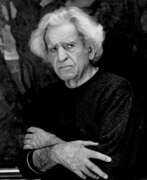

Nikolai Bagratovich Nikoghosyan (Russian: Николай Багратович Никогосян) was a Soviet Armenian sculptor and artist, celebrated for his mastery in creating expressive portraits and monumental sculptures that capture the essence and vitality of his subjects. Born in 1918, Nikoghosyan's art was significantly influenced by the Russian school of realistic sculpture and the national plastics of Armenia, reflecting a unique blend of cultural heritage and artistic innovation.
Throughout his remarkably long career, Nikoghosyan created a vast array of works, including over 200 busts in bronze, wood, and marble, 600 oil paintings, and 3,000 charcoal drawings. His artworks are appreciated worldwide, held in private collections across countries like France, Belgium, and Italy.
Nikoghosyan's significant contributions to art were recognized with numerous titles, including the People's Artist of the Armenian SSR, People's Artist of the USSR, and laureate of the USSR State Prize. His legacy is preserved and celebrated at the Nikoghosyan Cultural Foundation in Yerevan, Armenia, which showcases his sculptures, graphics, and paintings. The foundation not only serves as a tribute to Nikoghosyan's memory but also aims to inspire and support young Armenian artists.
For art enthusiasts and collectors, the work of Nikolai Bagratovich Nikoghosyan offers a fascinating glimpse into the blend of Armenian tradition and Soviet-era artistic expression, making his pieces highly sought after in the realms of both national and international art collections. To stay updated on exhibitions and auction events featuring Nikoghosyan's work, signing up for updates is highly recommended. This ensures you remain informed about opportunities to appreciate or acquire pieces by this master sculptor and artist.
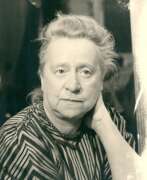

Nina Ilinichna Niss-Goldman (Russian: Нина Ильинична Нисс-Гольдман) was a Russian sculptor, born in 1893 in Rostov-on-Don. She embarked on her artistic journey in Kiev, where she began studying sculpture at the end of her secondary education. In 1911, Niss-Goldman moved to Paris to further her studies in sculpture for three years. This period was crucial for her development as an artist, allowing her to immerse herself in the vibrant artistic community of Paris. By 1915, she started participating in exhibitions in Moscow, marking the beginning of her professional career. Niss-Goldman's contributions to art did not stop at her creations; from 1925 to 1930, she shared her knowledge and skills by teaching at Vhuteine, influencing the next generation of artists.
Niss-Goldman's artistry was not confined to a single theme or style. Instead, she experimented with form and was closely associated with notable figures like Eli Nadelman and Hannah Orlova during her time in Paris between 1910 and 1915. Her work was known for its power and distinction, much like that of her contemporary, Beatrice Sandomirskaya. Niss-Goldman's statues and sculptures stood out for their compelling expression and technical mastery, making a significant impact in the art world.
For collectors and experts in art and antiques, Nina Ilinichna Niss-Goldman represents a fascinating figure whose works reflect a rich tapestry of influences and innovations. Her journey from Rostov-on-Don to Paris and then Moscow encapsulates a pivotal era in art history, marked by experimentation and a quest for new expressions. Her legacy, as both an artist and teacher, continues to inspire and captivate audiences.
To stay updated on exhibitions, sales, and auction events related to Nina Ilinichna Niss-Goldman, sign up for updates. This subscription is an excellent way for enthusiasts and collectors to remain informed about opportunities to engage with her work and learn more about her contributions to art.


Fritz Nuss is a German painter, sculptor and medalist, as well as a draftsman.
During his long creative life he created many sculptural works of art, which have been recognized at numerous exhibitions around the world. The theme of the sculptor Fritz Nuss's entire life was the human body, which he was able to depict in new facets and poses. His works captivate with purity of lines, monumental language, plasticity of form and a special, chamber emotionality and sensuality. Nuss created both small and large sculptures for public spaces; he designed the Elli-Heuss-Knapp memorial fountain in Stuttgart and many other large sculptures and fountains in Aalen, Freudenstadt, Göppingen, Stuttgart, etc.
Nuss was also a recognized medallist. The works he created can today be found in many famous coin collections around the world. At the end of his life, the half-blind artist, unable to sculpt, created many drawings that just as much praise the beauty of the human body.


Waldemar Otto is a German sculptor of Polish descent.
Otto studied sculpture at the Academy of Fine Arts in Berlin, won the 1957 Grosse Berliner Kunstausst Prize, lived with his family in the United States, and moved to Bremen in 1973, accepting a professorship at the University of the Arts. He founded the Bremer School of Sculpture there and then moved to Worpswede.
Waldemar Otto practiced figurative sculpture in the form of torsos, creating his figurative human images in wood, granite, bronze and cast stone. Many of his works can be seen in public spaces in various German cities.
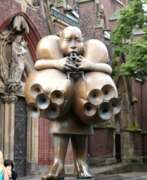

Kurt Sandweg was a German sculptor, graphic artist and university lecturer.
After World War II, where he was drafted and wounded, he studied at the Düsseldorf Academy of Fine Arts evening academy. Throughout his artistic life he was a member of the New Darmstadt Secession, chairman of the Düsseldorf Artists' Association, and a lecturer at the University of Duisburg in the Department of Art and Sculpture. For many years Kurt Sandweg was regarded as one of the most outstanding artists of Duisburg.
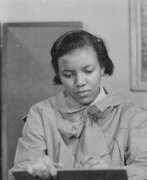

Augusta Savage was an American artist, renowned for her work in the Harlem Renaissance era. Born in Florida in 1892, Savage achieved fame for her sculptures that powerfully articulated the nuances of African American culture. Her journey from the American South to becoming a celebrated New York artist is an inspiring tale of resilience and talent in the face of adversity.
Savage's contributions went beyond her artistic creations; she was a passionate educator and advocate for equal rights in the arts. Her most famous work, "The Harp," inspired by the song "Lift Every Voice and Sing," was exhibited at the 1939 New York World's Fair, embodying the aspirations and struggles of African Americans. This piece, however, was sadly destroyed, as were many of her public works, leaving only a few pieces in museums today.
Despite the scarcity of her surviving works, Augusta Savage remains a pivotal figure in American art history. Her legacy endures through the artists she mentored and the barriers she broke, emphasizing the importance of representation in the arts. Collectors and experts recognize her sculptures not just for their aesthetic value but also for their historical significance.
Stay informed about exhibitions and sales featuring Augusta Savage's work. Sign up for updates and never miss an opportunity to explore her profound contributions to art and culture. This subscription will keep you alerted to new product sales and auction events specifically related to Augusta Savage.


Ernst Seger was a German sculptor and medalist, professor.
Seger studied at the Breslau School of Art with Robert Hertel and Christian Behrens, he also studied in Paris, and from the late 1880s he first executed large commissions for public monuments. The sculptor worked in Auguste Rodin's studio in Paris before opening his own studio in Berlin. Ernst Seger became famous primarily for his Art Nouveau female nudes.
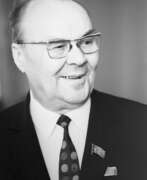

Nikolai Vasilyevich Tomsky (Russian: Никола́й Васи́льевич То́мский) was a distinguished Soviet sculptor, born in 1900 in the village of Staro Ramushevo, Novgorod province, into a family of a blacksmith. He became known for his monumental works that played a significant role in the artistry of the Socialist Realism era. Tomsky's educational journey in art commenced in Leningrad, where he graduated from the Arts and Crafts College in 1927. His rise to prominence began with his acclaimed memorial to Sergey Kirov, earning him the Stalin Prize in 1941. His work extended to designing Lenin's sarcophagus, creating Stalin's bust, and sculpting numerous statues of Lenin across the Soviet Union, including the notable red-granite Lenin in East Berlin.
Throughout his career, Tomsky received numerous accolades, including the title of Hero of Socialist Labor in 1970, multiple Orders of Lenin, and the Lenin Prize in 1972 for his granite monument of V.I. Lenin in Berlin. He was a laureate of the Stalin Prizes multiple times, received the USSR State Prize in 1979, and the State Prize of the RSFSR named after I.E. Repin in 1975 for his monument to M.I. Kutuzov in Moscow. His contributions to Soviet art were not only recognized in the USSR but also in the GDR, where he received the Order of Karl Marx.
Tomsky's works are celebrated for their ideological significance and artistic value, representing the Socialist Realism style's epitome. His sculptures, which include memorials to prominent Soviet figures and heroic compositions, are part of the cultural heritage of the Soviet era. For art collectors and experts in the field, Tomsky's creations offer a fascinating insight into the period's artistic and political landscape.
For those interested in the works and life of Nikolai Vasilyevich Tomsky, staying informed about new findings, sales, and auction events is essential. Signing up for updates can provide exclusive access to the latest information and opportunities to acquire pieces associated with this pivotal artist.
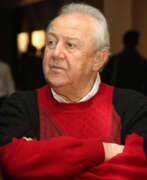

Zurab Konstantinovich Tsereteli (Russian: Зураб Константинович Церетели), a Georgian-Russian artist renowned for his monumental sculptures, has left an indelible mark on the landscape of modern art. Born in Tbilisi in 1934, Tsereteli expanded his artistic vision beyond painting after moving to Paris in the 1960s, where he was influenced by luminaries such as Picasso and Chagall. His work is characterized by a blend of dramatic, unconventional styles that have spurred debate but undeniably contributed to the cultural fabric of cities around the world.
Tsereteli's artworks, ranging from sculptures to paintings, are displayed globally, embodying his ethos that "art unites people." Noteworthy projects include the Peter the Great statue in Moscow, the Birth of the New Man in Seville, Spain, and the Tear of Grief in Bayonne, New Jersey, a poignant memorial to the victims of the 9/11 attacks. His commitment to fostering international cultural exchanges is evident in his role as the President of the Russian Academy of Arts and a UNESCO Goodwill Ambassador.
Beyond his public commissions, Tsereteli's contributions to education and the arts are profound. He founded the Moscow Museum of Modern Art and the Museum of Modern Art in Tbilisi, promoting modern and contemporary art in Russia and Georgia. His dedication to the Russian Academy of Arts underscores his belief in the importance of nurturing artistic talent and preserving the heritage of the academic school of fine arts.
For collectors and experts in art and antiques, Tsereteli's oeuvre offers a unique investment in pieces that are not only visually striking but also rich with cultural significance. His work encapsulates the dynamic interplay between traditional and contemporary art forms, making each piece a testament to his lifelong dedication to artistic innovation and cross-cultural dialogue.
To stay updated on new exhibitions, sales, and auction events related to Zurab Konstantinovich Tsereteli, sign up for updates. This subscription is a gateway to the latest developments in the world of a towering figure in art, offering exclusive insights into his ongoing contributions to the global art scene.


Fritz von Graevenitz was a German painter, sculptor and university lecturer. He studied fine art at the Academy of Fine Arts in Stuttgart.
The National Socialists promoted Fritz von Grevenitz as an artist and represented him several times at the Great German Art Fairs in Munich.
Fritz von Grevenitz mainly created monuments, cenotaphs, fountains, portraits and animal figures, most of which are in public places in German cities.
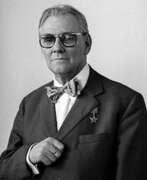

Yevgeny Viktorovich Vuchetich (Russian: Евгений Викторович Вучетич) was a Soviet sculptor and artist of significant acclaim, celebrated for his allegorical and heroic monuments, notably "The Motherland Calls," once the largest sculpture globally. Born in what is now Ukraine to a Montenegrin father and a Russian-French mother, Vuchetich's early life in Yekaterinoslav (Dnipro) set the stage for his illustrious career. His works, characterized by their grand scale and emotive power, encapsulate the spirit of Socialist Realism, earning him prestigious awards such as the Lenin Prize and Hero of Socialist Labor.
Vuchetich's contributions to Soviet monumental art are vast, including the renowned Soviet War Memorial in Treptower Park, Berlin, and the poignant "Let Us Beat Swords into Plowshares" located at the United Nations headquarters. His dedication to the military theme was not arbitrary; his volunteer service at the front during World War II profoundly influenced his artistic direction. This theme resonates through his works, immortalizing the valor and tragedy of war.
His oeuvre reflects a deep engagement with the cultural and historical milieu of his time, contributing significantly to the landscape of Soviet and global art. Among his notable works are the Treptower Park Memorial, the "Let Us Beat Swords into Plowshares" sculpture, and the iconic "The Motherland Calls," situated on Mamayev Kurgan, which stands as a testament to his legacy.
Collectors and experts in art and antiques admire Vuchetich's unique ability to merge ideological fervor with artistic mastery, making his works compelling subjects of study and appreciation. His sculptures not only capture the essence of an era marked by conflict and idealism but also continue to inspire through their aesthetic and symbolic significance.
For updates related to new product sales and auction events featuring Yevgeny Viktorovich Vuchetich's work, sign up for our newsletter. This subscription will keep you informed about opportunities to own a piece of history from one of the Soviet Union's most distinguished artists.


William Zorach, born Zorach Gorfinkel, was a Jewish American sculptor, painter, printmaker, and educator.
Zorach's family emigrated from Lithuania to the United States when he was four years old. He trained as a lithographer and studied painting at the Cleveland Institute of Art and in Paris, where he painted in bright colors in the manner of Henri Matisse and other artists of the Fauvism movement. Returning to the United States in 1912, Zorach became one of the first to introduce European modernist movements to the country. And later began to work extensively with sculpture.
William Zorach was a pioneer in the art of direct carving and is unique in that he often used very hard, colored and patterned stones like granite boulders he found while walking. Zorach's mature works are characterized by monumental forms and skillful use of the natural color, veining and texture of stone and wood. He often left traces of the sculptor's tools to enrich the surface.
Zorach was one of the best known and most respected sculptors of his generation. He was elected a member of the American Academy of Arts and Letters and taught at the Art Students League of New York.
